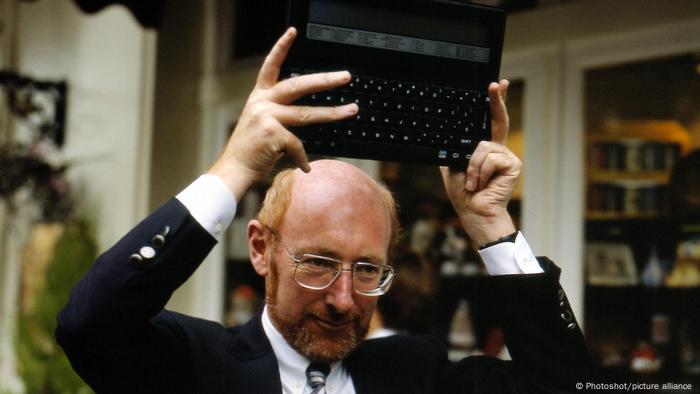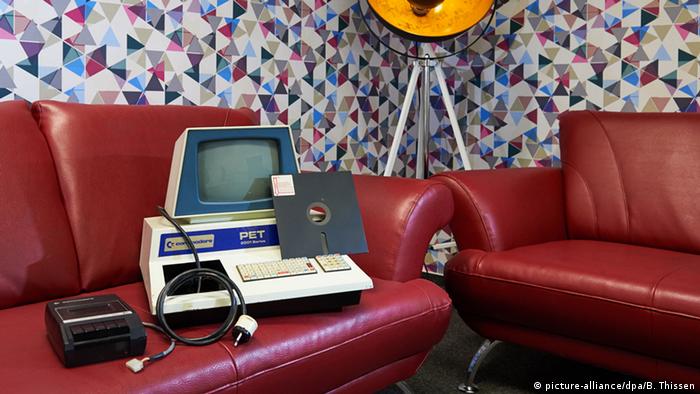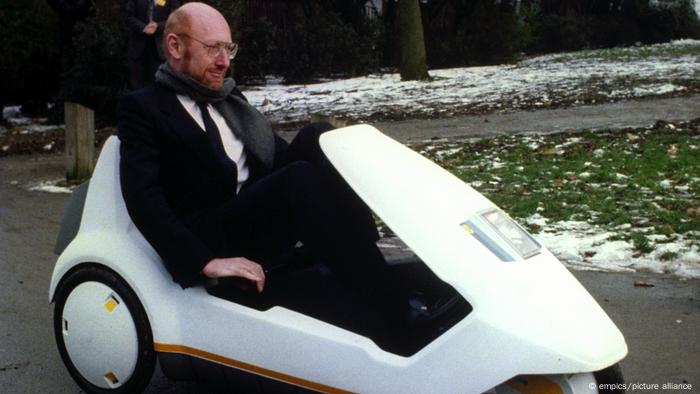
Sir Clive Sinclair is widely considered the pioneer of home computing and other consumer electronics, as well as the bizarre Sinclair C5. Belinda Sinclair, his daughter, told the press today that her father died at his London home early this morning, aged 81.
For those who have never heard or seen the Sinclair C5, it’s essentially a battery-powered recumbent tricycle for one person. In other words, it’s an electric tricycle with a polypropylene body and a chassis designed by Lotus Cars. Its 12-volt lead–acid electric battery powered a motor with a continuous rating of 250 watts and a maximum speed of 4,100 revolutions per minute, good for a range of 20-miles. The C5 was actually intended to be the first in a line of electric vehicles, but development of its successors, the C10 and C15 models, never progressed further due to poor sales of the C5.
He was inventive and imaginative and for him it was exciting and an adventure, it was his passion. He’d come up with an idea and say, ‘There’s no point in asking if someone wants it, because they can’t imagine it.’ He was a rather amazing person. Of course, he was so clever and he was always interested in everything,” said his daughter.
Sir Clive Sinclair, the man who helped bring affordable computers into people's homes in the 1980s, has passed away at the age of 81, UK media reported.

In 1988, Sinclair launched a laptop dubbed Cambridge Z88
British inventor Clive Sinclair, whose passion for technology made him a fortune and earned him a knighthood in the 1980s, has died following a long illness, his daughter Belinda told The Guardian daily and later the BBC on Thursday.
Sinclair was born in 1940 and started building gadgets as a child. He left school at 17 and worked as a technical journalist before starting his own company in 1961. In 1972, he launched a series of groundbreaking pocket calculators. The gadgets were a financial success and gathered praise for what was, at the time, a sleek, cutting-edge design.
But the inventor's personal golden age arrived in the early 1980s. Sinclair's home computer the ZX80 was designed to be cheap and accessible. Launched in 1980, it was also sold in kit form for customers who wanted to put the device together themselves. It was followed up by ZX81 and then ZX Spectrum 48K in 1982. The series rivaled the better known Commodore 64 in the early video game market.
Similar to other computer pioneers such as Steve Jobs and Bill Gates, Sinclair played a key role in bringing personal computers to people's homes. The computer boom also made him a millionaire.

COMPUTER DESIGN: FROM THE LEGENDARY Z3 TO THE APPLE WATCH
Design fit for a museum
The wunderkind from the early days of computer technology, the Commodore PET 2001 was released in 1977. Built to last, most are still fully functional. In 2016, the German Museum of Digital Culture (Deutsches Museum der digitalen Kultur) in Dortmund will put the old treasure in an honorable position. Its retro look is once again fashionable.
1234567891011
In 1983, he was awarded a knighthood by Queen Elizabeth II.
'A true father' of the computer age
In the mid-1980s, however, Sinclair faced his first flop with an early electric vehicle dubbed the Sinclair C5. In 1986, the inventor sold his computer business to the now-defunct Amstrad.
Several of his later inventions, including a pocket TV and an electric motor that could be fitted to a pedal bicycle, also failed to sell.

Sinclair admitted the 1985 launch of his electric vehicle, which could be powered by batteries or pedals, was botched — range, power, aesthetics and safety concerns were commonly cited as cause for public skepticism at the time
Sinclair continued to develop new gadgets into 2010s, as the world slowly embraced the dream of electric mobility.
Hollywood screenwriter and video game developer Garry Whitta also praised Sinclair as "a true father of the modern computing age."
"I'm not sure I'd be where I am today were it not for his ZX Spectrum igniting my love of computers and games," said Whitta, whose credits include the popular video game franchise Gears of War.
In a 2013 interview, Sinclair told the BBC that he did not himself use computers.
"I don't like distraction," he explained. "If I had a computer, I'd start thinking I could change this, I could change that, and I don't want to. My wife very kindly looks after that for me."
Thu., September 16, 2021,
Sir Clive Sinclair, who has died aged 81, was one of Britain's most prolific innovators.
Largely self-taught, he began inventing gadgets while he was still at school.
His ZX Spectrum computers brought affordable personal computing to the masses and sold in their millions across the world.
But his attempt to launch an electric vehicle was not successful, and caused him severe financial problems.
Clive Marles Sinclair was born on 30 July 1940 in Richmond, Surrey.
The young Clive was something of an introvert as a child, preferring the company of adults to that of his own age group.
He also developed a passion for creating gadgets, inspired by a character called The Inventor, on the BBC Children's series, Toytown.

A miniature TV was just one of the products he developed
Sinclair made a communications system for his hideout in the woods and built miniature radios and amplifiers.
While doing his A-levels, he designed a circuit for a simple radio which he then commissioned a manufacturer to make up into DIY kits.
The kit was sold through magazines such as Practical Wireless, a publication for which he had already written a number of articles.
Keen to return to inventing
Over the following four years, he wrote books on how to construct various electronic devices including radio receivers and transistor circuits.
But while his books sold well, Sinclair was anxious to get back to inventing, and formed his own company, Sinclair Radionics, in 1961.
He produced a number of printed circuit boards and a miniature transistor radio but was unable to raise enough capital to make the business a success.

Sinclair backed his products with heavy advertising
His first money-making venture came when he heard the Plessey company was discarding new transistors that were not up-to-scratch.
Having discovered the rejects still worked, Sinclair bought them in bulk, re-selling them at a profit and building them into his own products.
Sinclair followed up his kits with fully built hi-fi components and a design for a miniature TV.
He shared the view of Apple's Steve Jobs that design was everything and his products were seen as modern and cutting-edge.
Affordable pocket calculator
In 1972, he designed and released a calculator, the Sinclair Executive.
It was the first true pocket calculator and, while technically not particularly advanced, it looked good and, more importantly, was very affordable.
It won Design Council awards and was put on show at the Museum of Modern Art in New York.

The ZX Spectrum was a major success
But Sinclair's products were proving unreliable and the company faced financial problems.
An innovative quartz watch, a sleek black affair, never worked properly and customers returned them in their thousands.
Eventually the company was taken over by Labour's National Enterprise Board and split up.
"I'm not a businessman by nature," Sinclair once said, "but we all have to be businesslike in our lives."
Exciting innovations
Sinclair teamed up with Chris Curry who ran a small electronics company called Science of Cambridge. This quickly became Sinclair Research.
In 1980, the ZX80 was launched, a small computer that retailed at less than £100. Enthusiasts could buy it in kit form for £20 less.
It contained many exciting innovations and demonstrated Sinclair's ability to make a product work with the fewest possible number of components.

Sinclair sold his computer business to Alan Sugar's Amstrad
The follow-up, the ZX81, was still primitive by modern standards. But it would run simple applications and very basic games.
But the relationship between Sinclair and Curry soured following the BBC's decision to run a series on computer literacy, and to badge a machine for the programmes.
The corporation eventually chose Curry's Acorn machine which, while technically more advanced than the ZX81, was much more expensive.
Sinclair hit back with the ZX Spectrum. The big attraction was the colour display and, in its various incarnations, Sinclair sold more than five million machines.
He was knighted in 1983 at the recommendation of Margaret Thatcher, but his next big invention was to prove a disaster.
Electric vision
Misguidedly, Sir Clive was beginning to run into financial problems, due to the decision to put his energies, and his cash, into developing an electric vehicle.
Money was poured into research and development and the Sinclair C5 was launched in 1985.
Buyers were disappointed with its limited range, slow speed and inability to climb hills, while reviewers claimed it was unsafe, something Sinclair strongly denied.

The Sinclair C5 failed to find favour with the public
Sinclair himself later acknowledged the launch had been botched.
"The ground was covered in snow and we hadn't realised that the batteries virtually packed up in freezing conditions. It was a crazy time to launch it."
The pressures had an effect on his personal life. His 20-year marriage to his wife, Anne, ended in divorce.
Sir Clive gained something of a reputation as a playboy, often seen in public with beautiful, younger women on his arm.
He also developed a passion for poker, a game that appealed to his love of risk-taking and his willingness to bet his money against the odds.
Funded from personal wealth
Sinclair also faced problems with the launch of a new computer, the QL which, despite its innovative design, failed to sell in any great numbers.
After failed attempts to raise more cash, Sinclair sold the rights to his computers to Alan Sugar's Amstrad.
Sinclair Research continued to operate as a small research and development company marketing Sinclair's inventions and funded from his own personal wealth.

The folding bike was deemed by some to be almost impossible to ride
He was still fixated by the idea of an electric vehicle and, in 1992, launched the Zike, a lightweight electric bike. Like the C5, it failed to sell.
A folding bike, which could fit in a suitcase, it also failed when users declared it to be almost impossible to ride.
In 2011, he announced he was working on a new electric vehicle dubbed the X1.
Sir Clive Sinclair was a driving force behind the success of the now ubiquitous personal computer.
He built up a company that earned millions, won a string of awards and was given a knighthood by Margaret Thatcher. But his efforts were dogged by financial problems caused by the failure of his attempts to build an electric vehicle for the masses.
But he remained one of Britain's great innovators who could turn his dreams into reality. "The idea that an inventor can come up with some brilliant idea and somebody else will make it all happen is nonsense," he once said.
"Either you do it yourself or it ain't going to happen."
Keith Stuart
Fri, 17 September 2021,

Photograph: Peter Jordan/Alamy
One day, in the bitterly cold autumn of 1981, my dad brought something home with him which he said was a sort of present for the whole family. It was a ZX81 home computer. I’d seen them advertised on TV and in comics but I never imagined we’d own one; we didn’t even have a video recorder. I remember seeing the instruction manual for the first time, with its beautiful illustration of a gigantic starship, and I understood straightaway that the thing my dad was at that moment plugging into the TV was the future. My whole family sat around the screen and took it in turns to type in one of the BASIC program listings from that weighty booklet. The result was a game in which you had to input coordinates to throw a ball into a waste-paper basket. I can’t even begin to describe how exciting that was. There was something on the TV that we’d made, and that we could interact with. It was a revelation.
For families all over Britain, Clive Sinclair – who has died aged 81 – brought computers home. The hobbyist computer market, which introduced the likes of Bill Gates and Steve Wozniak to programming, was not as well-developed in this country and required some engineering expertise – you built computers such as the Altair 8800 yourself. The ZX81, you could buy in Boots or WH Smiths or from the Argos catalogue, and it was all there for you. For £70. A lot of money for my family at the time, but not too much.

A revelation … the Spectrum’s predecessor, the Sinclair ZX81.
Photograph: PhotoDreams/Alamy
When the ZX Spectrum arrived a year later, with its colour visuals and tinny audio, it was truly the beginning of the British games industry. Again, it was more affordable than the competition – the BBC Micro, Commodore VIC-20 or Apple II – so teenagers could be given them for Christmas, and could begin making their own games on the rubbery keyboard.
There was something slightly strange about this computer. To use the memory efficiently, each sprite (or moving character on screen) was stored separately from the pixel bitmap, and overlaid on top. The process meant that colours would often leak between objects on screen – a phenomenon known as attribute clash. But just like in other areas of culture, what looks like a technical failing actually became a signature aesthetic element of the games. They looked weird and offbeat and sketchy.
This appealed to the kids making games at the time; kids brought up on Monty Python and Pink Floyd, punk and The Young Ones. Games such as Jet Set Willy and Skool Daze were slightly anarchic, miniature alternative comedy sitcoms.They drew on what it meant to be an adolescent in the 80s, with its recession and unrest. The Darling Brothers, the Oliver Twins, Matthew Smith … they were the technological equivalent of the bedroom indie pop stars of the era, and the Spectrum was their secondhand Telecaster, their Roland 808 drum machine.
I owned a Commodore 64 but my cooler friends had Spectrums. When we played together they dug out strange games I’d never seen – Atic Atac, Travel With Trashman, Fat Worm Blows a Sparky – and these experiences were as important to me as the first time I heard Afrika Bambaataa or Madonna, or the first time I saw Blade Runner on a knackered videotape. Those games came to us because of the affordable and unorthodox Spectrum, and the culture of bedroom game development it fostered.
Later, while at university, I did some summer work for Codemasters, the software studio set up by brothers Richard and David Darling with the intention of selling cheap, fun game cassettes for a couple of quid each. This was where classics such as Dizzy and BMX Simulator were born. I worked with a team named Big Red Software which handled various projects for Codies, including two Spectrum games in the winter of the machine’s life: CJ’s Elephant Antics and Wild West Seymour. Here, I worked with two brilliant programmers, Fred Williams and my lifelong friend Jon Cartwright. I got to see how clever this machine was, how adaptable, and how much joy there was still to be found in wrestling images from its ageing hardware.
“The first time I coded a Spectrum was when I blagged my way into a summer job at Big Red,” recalls Jon. “I ended up writing Dizzy: Prince of the Yolkfolk. I enjoyed coding on the Spectrum. It didn’t have the hardware sprites of the Commodore 64, and of course it had all the attribute issues of only allowing you to have two colours in each 8x8 pixel region. But honestly, those limitations drove the design of the best games.
“Shahid Kamal Ahmad’s recent Twitter thread about porting Jet Set Willy to Commodore 64 covers that well. If Jet Set Willy had been born on the C64 it would have looked and sounded so different. There were artists that specialised in doing loading screens for Speccy games. Given its limitations, it really was quite a skill. There was an anticipation too, as the screen slowly loaded in, line by line, often in black and white, almost unintelligible until finally the attributes for each 8x8 block were coloured in and it all made sense.
Even now, whenever I write about games for the Guardian, the classic titles that get readers chatting most fondly in the comments sections are Spectrum games. Jet Set Willy. Horace Goes Skiing. Knight Lore. For my generation, they retain a hold on the collective imagination and on our sense of 80s popular culture. To us, the bedroom coders that Clive Sinclair facilitated were like poets and comedians and rock stars, and they did what all struggling artists do: they made use of a tool that was affordable, expressive and open to manipulation and accident. Sinclair was as much our Brian Eno as he was our Bill Gates – he made game designers and artists and electronic musicians of so many people. I hope he realised that. I hope he knew.
Sadly our old ZX81 is long gone, though I kept it for many years. I wish I still had it. I guess everything I’ve done in my life as a professional writer started that day my dad brought that funny-looking computer home, and with it, the future.
For many, the 1980s was the golden era in home computing. Low cost 8-bit systems brought arcade games to the masses, while offering the ability to handle basic office tasks at the same time. Companies such as Acorn, Commodore, and Dragon rapidly become household names.
And fighting for sales amongst them all, was a tiny British company. Their computers were cheap and basic, but helped give rise to the world of bedroom programming and some very familiar game developers. Join us, as we reminisce about the brief life of Sinclair computers.
The early battles for success
British inventor and entrepreneur, Clive Sinclair, set up his first company, Sinclair Radionics Ltd. in 1961, selling a variety of electrical and electronic products for the home. It performed well for over 10 years, thanks to the buoyant economy at the time, and a highly successful product -- a digital calculator, called the Sinclair Executive.
Unfortunately, disastrous flirtations with the development of portal televisions and digital watches drained the bank balance, resulting in the company closing its doors. But Sinclair didn't let this get in the way of his desire to innovate and by the late 1970s, he was back again, in the form of Science of Cambridge Ltd.
Encouraged by developments made in the microprocessor world, his tiny group of engineers created the MK14 -- one of the first home computers made in the UK (sold in kit form). Its unexpected success proved that there was a market for this product, and following another change in the company name (Sinclair Computers Ltd), they had their next big success.

Despite its flaws, the ZX80 was very popular. Source: Wikipedia
By today's standards, the ZX80 might seem like a complete joke, but $230 (£100) in 1980 got you an 8-bit 3.25 MHz Zilog Z80 clone processor, 1 kB of 8-bit wide SRAM, and 4 kB of ROM -- a surprising amount of technology for that budget.
It did come with some drawbacks, though, due to the cost cutting: there was no audio output, nor any real hardware to create the video signal. The visual output was mostly handled by the Z80 chip, in an interrupt mode; so pressing any key on the pad or executing any code would result in an momentary loss of the screen!
The visual output was mostly handled by the Z80 chip, in an interrupt mode; so pressing any key on the pad or executing any code would result in an momentary loss of the screen!
Despite these issues, the ZX80 repeatedly sold out, and put Sinclair firmly on the map, as a serious competitor in the home computer market.
In 1981, the company was renamed yet again to become Sinclair Research Ltd, and shortly after they launched the ZX80's successor, the ZX81.

Attached to the rear of this ZX81 is the notorious 16 kB RAM expansion pack. Source: Wikipedia
Much of the architecture and specifications remained the same, but it was cheaper to manufacture (using an uncommitted logic array chip, ULA, to replace a raft of logic components) and had double the ROM, enabling a better instruction set to be used. The screen blanking problem was gone, and there was even basic audio output.
The ZX81 was somewhat rushed, and had reliability flaws, but it cost 30% less than its predecessor -- naturally, it sold by the proverbial bucket load, and earned Sinclair Research a small fortune. And the best was yet to come.
Sinclair's zenith
The biggest criticism of the ZX81 was the paucity of RAM -- just 1 kB of it, although it could be expanded, by use of a very wobbly add-on board, to 16 kB or 56 kB. For games and other graphics-based programs, the restrictive monochrome 64 x 48 pixel resolution was also commonly berated.
Some clever programming could get around the resolution limitation, but what was really needed, was more capable hardware. Sinclair Research was aware of this, and their answer came in April 1982: the ZX Spectrum.

The original ZX Spectrum, replete with the 'dead flesh' chiclet keyboard. Source: Wikipedia
Two versions were available that differed only in price and the amount of memory installed: 16 kB for $220 (£125) and 48 kB for $310 (£175). This was a substantial increase in price over the ZX81, but the various improvements justified the rise.
Like its predecessor, the Spectrum used a ULA to perform many of the standard functions, but this time it provided a real hardware solution for creating the frame raster. This was previously handled by the Z80 processor and freed from that task, it could be dedicated entirely to executing programs.
It also gained a small clock improvement to 3.5 MHz -- altogether, the Spectrum's processing capability was roughly four times better than the ZX81. The hardware raster was also much higher in resolution (256 x 192 pixels) and was finally in color.
This aspect was handled in 8 x 8 pixel blocks of just 15 possible colors: black, and two levels of brightness for 7 base colors. Unfortunately, due to memory restrictions, only a single foreground and background color could be set for the whole block.
The effect of this was something called attribute clash, where changing just one pixel in the block would switch the rest to the same color, leading to undesirable visuals, especially in animation.
Early game developers for the platform didn't bother to avoid the problem, but later titles demonstrated some ingenious tricks to mask it.

The price resulted in the use of off-the-shelf components and suspect build quality. Source: Wikipedia
The ZX80/81's use of SRAM was gone, too, replaced by 2.7 MHz 1-bit wide DRAM. While not as good as SRAM, the change was necessary to increase the memory footprint and still keep the cost down. Other aspects of the Spectrum pointed to sale price restrictions, the most notable of which was the keyboard. The rubber block keys were considered to be unpleasant to use, and the membrane underneath often developed faults.
Home computers of this era were almost entirely assembled by hand, leading to the occasional problem with soldering quality, and misplaced or incorrect components being fitted. But it didn't really matter -- Sinclair had another huge hit on their hands and revenue almost tripled within 2 years (aided by a significant price drop 12 months after launch).

The first major update: 128 kB of RAM and a big heatsink to burn your hand on. Source: Wikipedia
Over a period of four years, the ZX Spectrum was updated twice: the Spectrum+ arrived in October 1984 (same internals with a better keyboard) and the Spectrum 128 in the latter months of 1985. This version offered 128 kB (in the form of two 64 kB switchable banks), a dedicated audio chip, and more ports for expansion and video options.
It was also to be Sinclair's final home computer -- for all its popularity, the Spectrum couldn't save the company from suffering crippling losses. So what exactly went wrong?
It was all so brief
In 1982, Sinclair agreed to a licencing deal with Timex Corporation, an American producer of clocks and watches. They were already the primary manufacturer of Sinclair's product (the production line being based in Dundee, Scotland) and the boom in home computing tempted the firm to try their hand at expanding their product portfolio, to offset falling sales in their main sector.
The joint venture, labelled Timex Sinclair, did more than just sell rebranded ZX81 and Spectrum machines -- instead, Timex attempted to enhance the base platform, either in the form of additional RAM, better chips, or additional expansion systems.
How much income this generated for Sinclair is uncertain, but poor sales in America forced Timex to withdraw from that region by 1984, although they carried on in other countries until the early 1990s.

The last Timex Sinclair home computer to be sold in the US. Source: Wikipedia
Where the ZX Spectrum was the best selling home computer in the UK, Timex Sinclair machines didn't sell anywhere near as well. The likes of Commodore and Atari were far more competitive on price and product development. In 1985, the former company released the Amiga 1000, a very powerful (and expensive) machine.
Its capabilities were far superior to the likes of the lowly ZX Spectrum and was well received in business sectors. Sinclair Research had tried to penetrate the same market a year earlier, with the Sinclair QL ('Quantum Leap').
Both the Amiga 1000 and the QL used a Motorola 68000 series chip for the main processor. This was a hybrid device: it had 32-bit registers and the same size internal data bus, but the memory address bus was 24-bits, the logic units and external data bus were 16-bits wide.

Despite this complexity, the Motorola processor was easy to work with and very capable. For the QL, Sinclair used the cheaper 68008 version -- the clock speed was an impressive 7.5 MHz, but the address and external memory buses were narrower, at 20 and 8 bits, respectively.
The base price for this computer was $560 (£400), sporting 128 kB of RAM, and twin Microdrive slots (a proprietary magnetic tape storage system). It should have been very tempting for smaller firms with a tight budgets or government bodies looking to cut costs. However, the whole project was both rushed and delayed, and launched with numerous bugs and reliability problems.
It also looked almost identical to the ZX Spectrum+, which was universally recognised as a gaming computer for children. Unsurprisingly, it sold poorly and was officially discontinued after just two years.

The very last Sinclair badged home computer. Source: Wikipedia
Sinclair Research had also tried to develop and sell other products: a wrist watch with a built-in FM radio, an electric tricycle, and a pocket television, but they were all commercial failures and pushed the firm into bankruptcy.
With Clive Sinclair losing millions of his own money, the inevitable happened in 1986 -- the Sinclair brand name and all products were sold to another British electronics firm, Amstrad.
This company continued to develop the ZX Spectrum but by December 1990 it was all over. Business users had moved onto Windows-based PCs, and gamers favored the likes of the Atari ST and consoles. Production of the old favorite was called to a halt and Sinclair computers passed into history.
A golden legacy
So why should we be recounting the tales of company that had such a brief moment of glory? The hardware wasn't particularly unique, especially compared to its immediate competitors, although it was cheaper. The ZX81 and ZX Spectrum sold incredibly well in the UK, but significantly less so in other markets.
It is precisely because of these that we still talk about the likes of the ZX Spectrum. Its limitations and large user base gave rise to some of the best known game creators today. British developers, Ultimate Play The Game, achieved critical success on the platform, pathing their way to becoming Rare (makers of Donkey Kong, GoldenEye 007, Banjo-Kazooie, and many other famous games).

Ultimate's Knight Lore - a seminal achievement in gaming history. Source: Wikipedia
Codemasters, purveyors of countless racing games, cut their programming teeth on 8-bit computers -- all from the comfort of their bedrooms, after school. And Rockstar North can trace their history back to the mid-1980s, where they were no strangers to the joys of programming a Sinclair machine.
So it should come as no surprise to learn that the ZX Spectrum still lives on, in the form of emulators and numerous fan websites. There's even been several attempts to hop onto the mini-console nostalgia bandwagon, in the form of crowd-funded projects such as the Spectrum Vega and Next.
But even if you never owned one, or haven't even heard of it before, the games you play today owe no small debt to the plucky little box. Gone, but absolutely not forgotten.
Clive Sinclair - Wikipedia
Sinclair's father and grandfather were engineers; both had been apprentices at Vickers the shipbuilders. His grandfather George Sinclair was an innovative naval architect who got the paravane, a mine sweeping device, to work. George Sinclair's son, George William "Bill" Sinclair, wanted to take religious orders or become a journalist. His father suggested he train as an engineer first; Bill became a mechanical engineer and remained in th…















